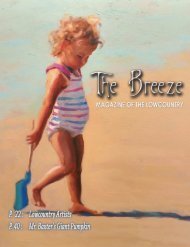You also want an ePaper? Increase the reach of your titles
YUMPU automatically turns print PDFs into web optimized ePapers that Google loves.
Nonetheless, here is a cheat sheet showing the extremes<br />
of wines:<br />
-- Clarity: Cloudy/dull vs. brilliant<br />
-- Depth of color: Watery vs. deep<br />
-- Color (Whites) green tinge vs. pale/deep yellow<br />
-- Color (Reds) Purple vs. red brown<br />
-- Viscosity: water vs. oil<br />
<strong>The</strong>se extremes are associated with both good and<br />
mediocre wine, but don’t take them too literally because<br />
major exceptions do exist. For example, a chardonnay aged<br />
in oak (particularly if made “ sur lie”) will take on a golden<br />
hue, while the same varietal aged in steel vats will look<br />
pale in comparison. Both methods, however, can deliver<br />
excellent wine.<br />
To observe any of these attributes, tilt the glass and pay<br />
close attention to the top ½ inch of wine, particularly near<br />
the rim, and finally, if you really want to check the color of<br />
a red wine dip the corner of a paper napkin into the wine.<br />
Finally, the legs (or tears) in wine are attributable to<br />
either high sugar and/or alcohol, and are not necessarily<br />
indicators of quality.<br />
Quality Checks<br />
Although I could argue that the globalization of wine<br />
amounts to making wine generic, it has also brought a<br />
huge benefit called quality control. Wine making today is<br />
a hygienic, honed science and it is very rare to encounter<br />
a “bad” bottle.<br />
But it’s good to double check.<br />
When you have just ordered a<br />
$40 bottle of wine, you may take<br />
these simple steps to ensure that<br />
the wine has not been damaged:<br />
<strong>The</strong> cork must come out<br />
smoothly, and the wine stains<br />
up the sides of the cork should<br />
not be more than a 1/4-inch<br />
long. (crystals on the bottom<br />
of the cork are ok). If the wine<br />
is less than 10 years old, and<br />
the cork crumbles, send it back.<br />
Don’t bother smelling the cork<br />
because it will offer no further<br />
clues. Instead, have the waiter<br />
pour a small amount, but do<br />
NOT swirl the glass or sip the<br />
wine. Use your nose to detect<br />
something which is quickly<br />
obnoxious, such as vinegar, glue,<br />
mold or a damp basement. <strong>The</strong><br />
quicker you smell something<br />
truly odd, the more likely the wine has gone bad. <strong>The</strong><br />
moment you swirl the glass to oxidize the wine and release<br />
the fruit (even bad wine has residual fruit and alcohol), your<br />
chances of identifying the obnoxious smell will become<br />
much harder…..an old French sommelier trick. On the<br />
other hand, if you have just ordered a wine by the glass,<br />
your biggest enemy will be oxygen. Unless the bottle was<br />
vacuum sealed, the wine will have become flat with hints<br />
of vinegar.<br />
Practice Makes Perfect<br />
<strong>The</strong> moral of the story is that as you become more confident<br />
with wine, and particularly with the style or varietal you<br />
prefer, you can use your knowledge to your advantage.<br />
<strong>The</strong> next time you buy a wine which you know you enjoyed<br />
in the past, take the time to go through the steps above.<br />
Ninety-nine percent of the time the wine will not be<br />
damaged, but the process will teach you the look and smell<br />
of the wine as it comes out of the bottle (remember not to<br />
swirl at first!).<br />
Assuming all systems are a go, swirl with abandon and<br />
then try to commit to memory the “nose” of the wine you<br />
like because I’m convinced our noses are hard-wired to the<br />
brain, and won’t forget what pleases us. <strong>The</strong> last step is to<br />
knock it down with a good mouthful, but this time, please<br />
don’t continue with abandon!<br />
Cheers.<br />
Fifty Shades of White? Yes there are more than you can imagine -- and it can be<br />
argued there is no such thing as “white” wine! Here are five to illustrate the point: <strong>The</strong><br />
deep yellow-gold hue of a moscato. A softer gold from California chardonnay. <strong>The</strong><br />
pale flinty color of New Zealand sauvignon blanc. <strong>The</strong> greenish glow of chenin blanc.<br />
And the stronger green that gives Portuguese “vinho verde” its name. All modestly<br />
priced, found at Kroger and Big Jim’s. Enjoy.<br />
39

















